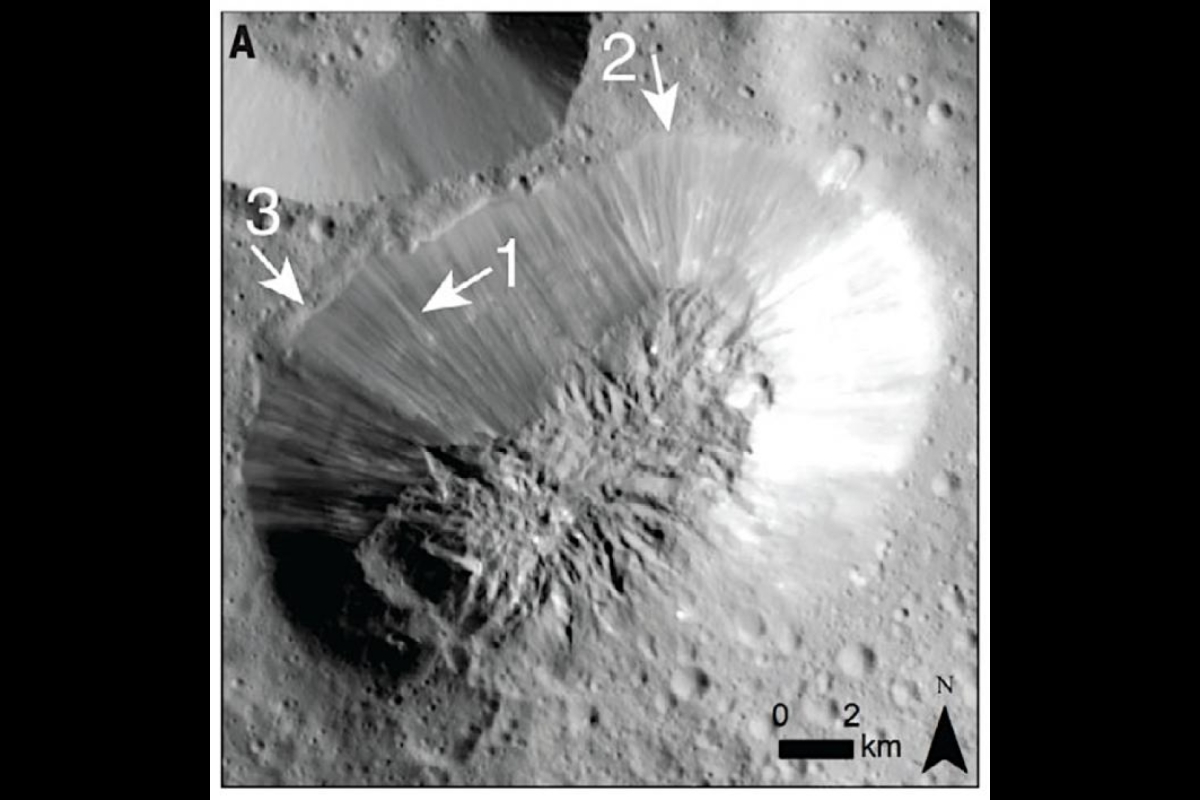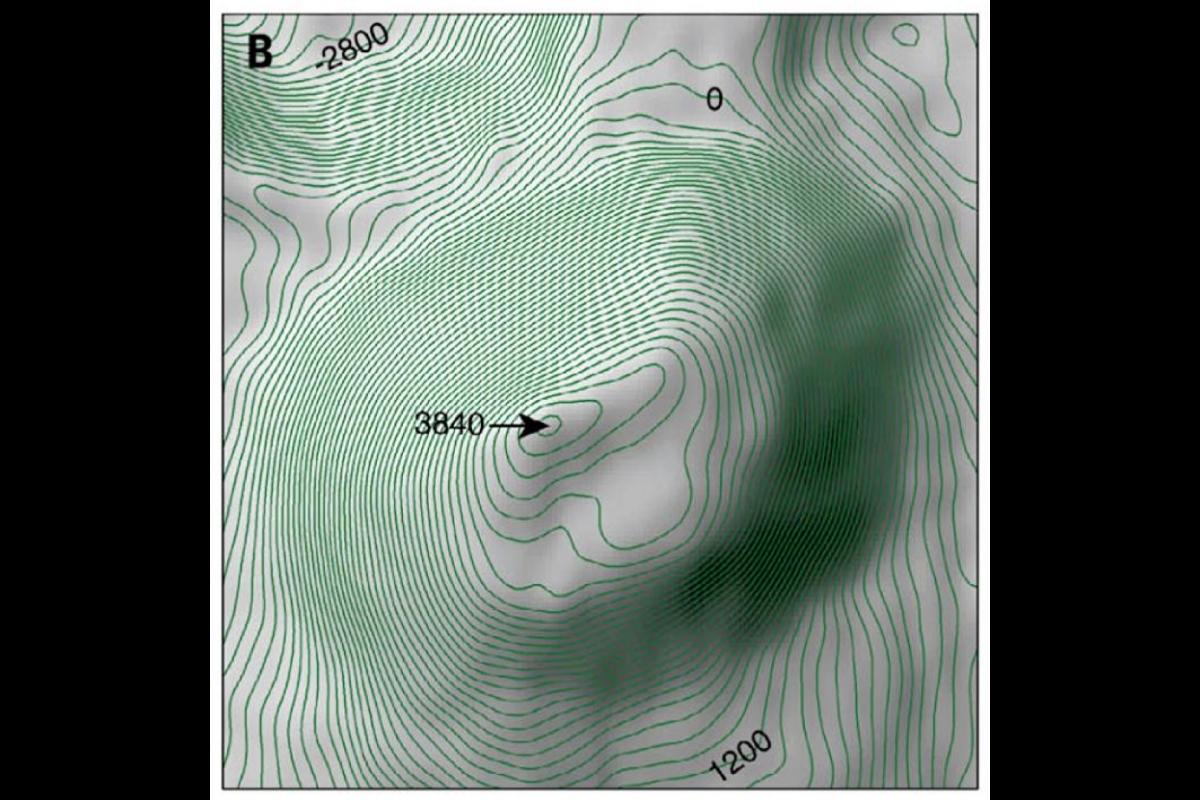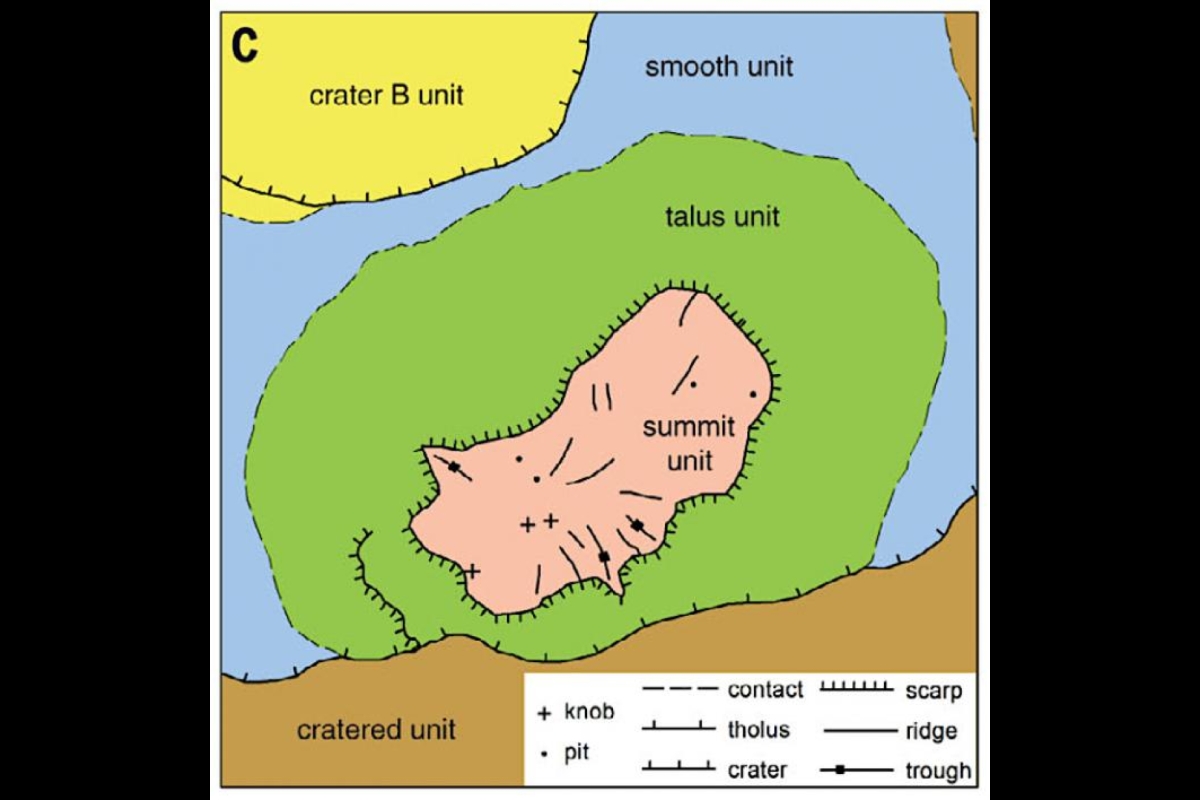Ceres: The tiny world where volcanoes erupt ice

Volcanic dome Ahuna Mons rises above a foreground impact crater, as seen by NASA's Dawn spacecraft with no vertical exaggeration. Eruptions of salty, muddy water built the mountain by repeated eruptions, flows and freezing. Streaks from falls of rocks and debris run down its flanks, while overhead views show fracturing across its summit. Photo courtesy of Dawn Science Team and NASA/JPL-Caltech/GSFC
Ahuna Mons is a volcano that rises 13,000 feet high and spreads 11 miles wide at its base. This would be impressive for a volcano on Earth. But Ahuna Mons stands on Ceres, a dwarf planet less than 600 miles wide that orbits the sun between Mars and Jupiter. Even stranger, Ahuna Mons isn't built from lava the way terrestrial volcanoes are — it's built from ice.
"Ahuna is the one true 'mountain' on Ceres," said David A. Williams, associate research professor in Arizona State University's School of Earth and Space Exploration. "After studying it closely, we interpret it as a dome raised by cryovolcanism."
This is a form of low-temperature volcanic activity, where molten ice — water, usually mixed with salts or ammonia — replaces the molten silicate rock erupted by terrestrial volcanoes. Giant mountain Ahuna is a volcanic dome built from repeated eruptions of freezing salty water.
Williams is part of a team of scientists working with NASA's Dawn mission who have published papers in the journal Science this week. His specialty is volcanism, and that drew him to the puzzle of Ahuna Mons.
"Ahuna is truly unique, being the only mountain of its kind on Ceres," he said. "It shows nothing to indicate a tectonic formation, so that led us to consider cryovolcanism as a method for its origin."
Dawn scientist Ottaviano Ruesch, of NASA's Goddard Space Flight Center in Greenbelt, Maryland, is the lead author on the Science paper about Ceres volcanism. He says, "This is the only known example of a cryovolcano that potentially formed from a salty mud mix, and which formed in the geologically recent past."
Williams explained that "Ahuna has only a few craters on its surface, which points to an age of just couple hundred million years at most."
According to the Dawn team, the implications of Ahuna Mons being volcanic in origin are enormous. It confirms that although Ceres' surface temperature averages almost –40° (Celsius or Fahrenheit; the scales converge at this temperature), its interior has kept warm enough for liquid water or brines to exist for a relatively long period. And this has allowed volcanic activity at the surface in recent geological time.
Ahuna Mons is not the only place where icy volcanism happens on Ceres. Dawn's instruments have spotted features that point to cryovolcanic activity that resurfaces areas rather than building tall structures. Numerous craters, for example, show floors that appear flatter than impacts by meteorites would leave them, so perhaps they have been flooded from below. In addition, such flat-floored craters often show cracks suggesting that icy "magma" has pushed them upward, then subsided.
A few places on Ceres exhibit a geo-museum of features. "Occator Crater has several bright spots on its floor," said Williams. "The central spot contains what looks like a cryovolcanic dome, rich in sodium carbonates." Other bright spots, he says, occur over fractures that suggest venting of water vapor mixed with bright salts.
"As the vapor has boiled away," he explained, "it leaves the bright 1salts and carbonate minerals behind. "
Looking inside
Although volcanic-related features appear across the surface of Ceres, for scientists perhaps the most interesting aspect is what these features say about the interior of the dwarf world. Dawn observations suggest that Ceres has an outer shell that's not purely ice or rock, but rather a mixture of both.
Recently, Williams was involved in research that discovered that large impact craters are missing, presumably erased by internal heat, but smaller craters are preserved.
"This shows that Ceres' crust has a variable composition — it's weak at large scales but strong at smaller scales," he said. "It has also evolved geologically."
In the big picture, said Williams, "Ceres appears differentiated internally, with a core and a complex crust made of 30 to 40 percent water ice mixed with silicate rock and salts." And perhaps pockets of brine still exist in its interior.
"We need to continue studying the data to better understand the interior structure of Ceres," said Williams.
Ceres is the second port of call for the Dawn mission, which was launched in 2007 and visited another asteroid, Vesta, from 2011 to 2012. The spacecraft arrived at Ceres in March 2015. It carries a suite of cameras, spectrometers and gamma-ray and neutron detectors. These were built to image, map and measure the shape and surface materials of Ceres, and they collect information to help scientists understand the history of these small worlds and what they can tell us of the solar system's birth.
NASA plans for Dawn to continue orbiting Ceres and collecting data for another year or so. The dwarf planet is slowly moving toward its closest approach to the sun, called perihelion, which will come in April 2018. Scientists expect that the growing solar warmth will produce some detectable changes in Ceres' surface or maybe even trigger volcanic activity.
"We hope that by observing Ceres as it approaches perihelion, we might observe some active venting. This would be an ideal way to end the mission," said Williams.
More Science and technology

ASU-led space telescope is ready to fly
The Star Planet Activity Research CubeSat, or SPARCS, a small space telescope that will monitor the flares and sunspot activity…

ASU at the heart of the state's revitalized microelectronics industry
A stronger local economy, more reliable technology, and a future where our computers and devices do the impossible: that’s the…

Breakthrough copper alloy achieves unprecedented high-temperature performance
A team of researchers from Arizona State University, the U.S. Army Research Laboratory, Lehigh University and Louisiana State…




